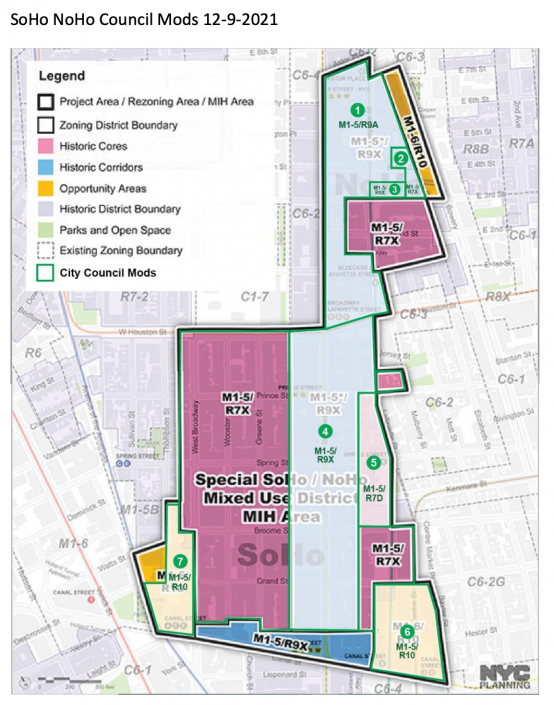Trending
City Council tweaks Soho rezoning, assuring its passage
Despite some concessions on density, a victory for de Blasio and real estate

An agreement has been reached to get the Soho and Noho rezoning across the finish line, reducing the density proposed by the de Blasio administration.
Despite the last-minute changes, the plan as a whole will dramatically increase the amount of development allowed in the high-income, relatively low-scale neighborhoods. It is a victory for the administration and advocates for affordable housing, not to mention the real estate industry.
The City Council zoning subcommittee and the Committee on Land Use voted Thursday on the modified plan, which reduces the commercial floor-area ratio in most of the rezoning area to 5 from the original proposal, in which FAR was 10 in three areas. In the Bowery corridor in Noho, the commercial FAR is 7 and the residential FAR is 12, as recommended by City Planning.
The parameters will encourage developers to build homes instead of office and retail space, drawing praise from the pro-housing group Open New York.
“For the first time, we’re seeing what happens when the system doesn’t cave to parochial special interests committed to an unworkable status quo: Wealthy neighborhoods are being required to build their fair share and New York City is finally on a path to abundant, affordable, and equitable housing,” Will Thomas, executive director of the group, said in a statement.
By “the system,” Thomas was referring to the City Council, notably the two local members who controlled the outcome, and Mayor Bill de Blasio.
The organization had been scrambling all week — after more than a year of tussling with anti-development locals — to beat back efforts to cut residential density from the plan.
In another part of Noho, described as the historic corridor of the area, residential FAR was decreased to 8.5 from the proposed 9.7. A small area nearby, dubbed Noho’s historic core, had its residential FAR cut to 6 from 9.7. The residential FAR in a portion of southeastern Soho was also cut to 5.6 from 6.
The amended application caps the size of food and beverage establishments at 8,500 square feet and bars dormitory and university use. It also creates a special permit process for approving retail space larger than 10,000 square feet on narrow streets and 25,000 square feet on wide ones.
The revisions also remove the Mandatory Inclusionary Housing program’s “option 2,” in which 30 percent of apartments in new projects are set aside for residents making 80 percent or less than the area median income. The program’s other choices largely require deeper affordability.
Council member Carlina Rivera, who represents a small part of the rezoning area in Noho, said that the “finished product is not perfect,” but that the amount of permitted commercial density was reduced as much as possible. She accused the Department of City Planning of failing to seriously consider concerns raised by elected officials and community groups.
The proposal updates the neighborhood’s outdated zoning, which primarily allows for manufacturing use despite its having become a prime retail destination.

The rezoning was the first test of the city’s ability to apply the mayor’s signature affordability program, Mandatory Inclusionary Housing, in a predominantly white and affluent Manhattan neighborhood. The administration has been criticized from both ends of the political spectrum for focusing on low-income areas.
“It is really time that we make sure that every neighborhood in the city contributes to building affordable housing,” said Council member Margaret Chin, who represents the bulk of the rezoning area, at the subcommittee meeting. “A neighborhood like Soho, Noho, where it is wealthy, resource-rich, they need to also contribute to the opportunity of creating more affordable housing.”
She added, “At the same time, we will be able to help maintain the artistic and cultural character of this wonderful neighborhood.”
A plan for Gowanus approved last month was the administration’s first large-scale rezoning in a wealthy area.
Opponents of the city’s Soho plan called for less density, arguing that new development would displace rent-regulated tenants, attract big-box retail and endanger historic districts, while failing to achieve the city’s affordable housing goals.
One of the groups, NoHo Bowery Stakeholders, pushed this week to reduce the plan’s residential floor-area ratios in Noho, alarming housing advocates who said the change would induce commercial development. Ultimately, the City Council did not reduce residential FAR as much as the group wanted.
Another group that has opposed the rezoning, Village Preservation, was not impressed by the City Council’s changes.
“It’s shameful that the Council did not listen to the housing and tenant advocates, the environmental groups, the Chinatown leaders, the anti-displacement advocates, the local community board, the national preservation organizations, and the literally tens of thousands of New Yorkers who wrote, called, and emailed them to reject this plan,” Andrew Berman, the longtime executive director of the organization, said in a statement.
Under the original rezoning plan, officials estimated that 1,829 residential units would be created over the next decade, with 382 to 573 of them affordable. In the 10 years after that, another 1,719, with 365 to 545 permanently affordable, could be built. Updated counts on the expected development have not yet been provided.
With the deal in place, the rezoning is expected to be approved by the full Council next week.




